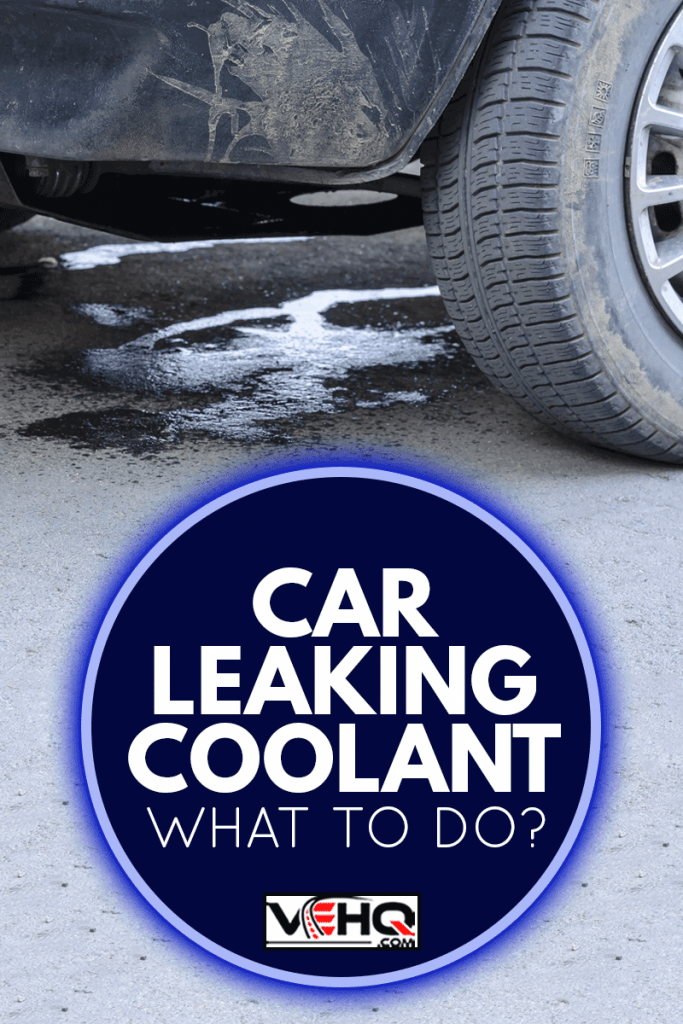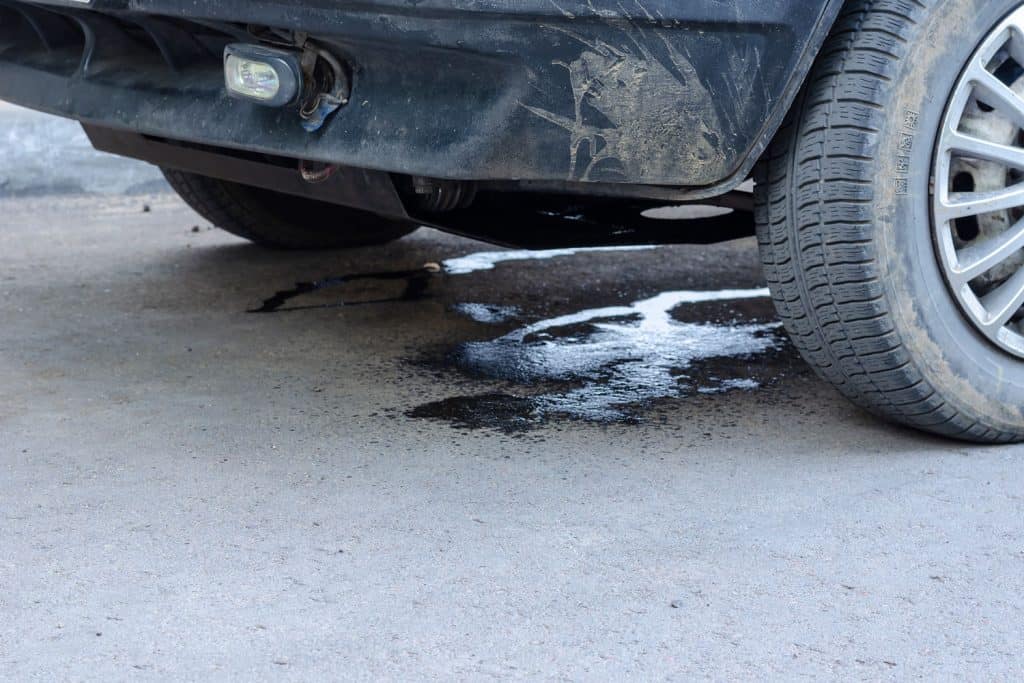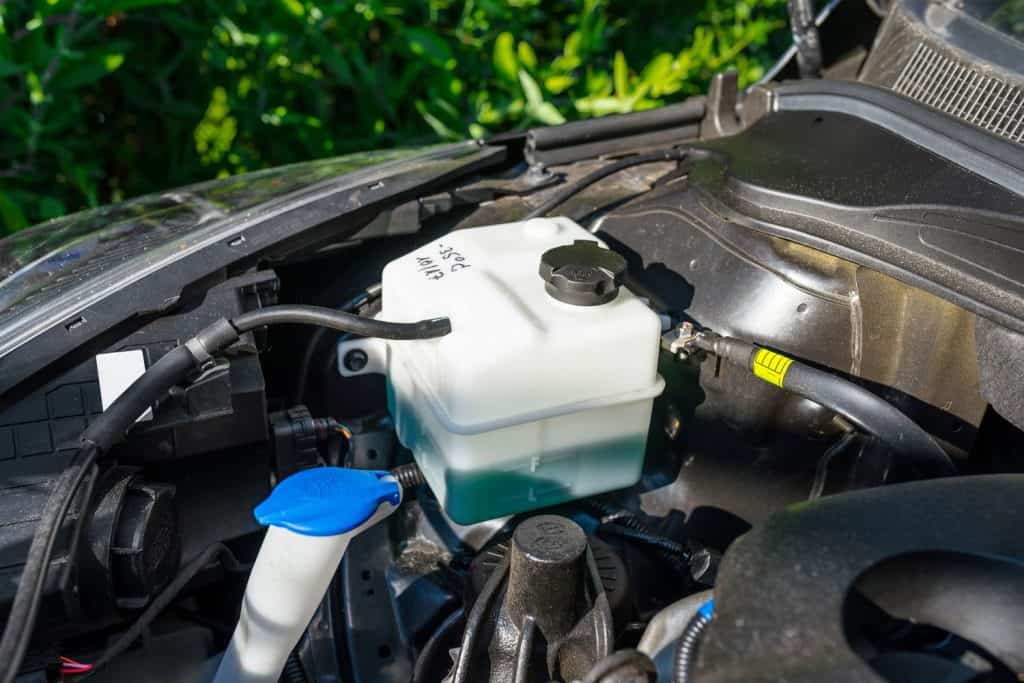You feel your car running hot and notice a sweet smell. These could be signs of your coolant, also known as antifreeze, leaking, and now you're wondering what to do before further damage happens. We've taken a look into what to do for you and found the answer.
If you smell a sweet and strange odor when driving your vehicle, this is a tell-tale sign of a coolant leak. You'll want to stop driving the car before it starts smoking a white or grey color. Follow this list to pull yourself over safely:
- Pull over slowly into a safe area- your driveway or a calm parking lot will work
- Turn the car off
- Open door or windows to air out smells
- Let the engine cool before opening it (about 15 minutes)
Troubleshooting for when you are:
Sitting:
- White or Gray Smoke
- Colored puddles
- Strong smell under the hood
- Low level in the tank
Driving:
- White or Gray Smoke
- Overheats
- Temperature gauge spikes to hot
- Radiator light comes on the dash
Driving with a coolant leak can cause other issues to pop up. If you notice colored puddles under your vehicle when it's parked or after running, it's time to take a look under the hood. In this post, we'll go into detail about finding the leak, types of coolant, and the cost of fixing leaks.

Potential Leak Issues and their fixes
As you can see, there is a number of signs that point to coolant problems in your vehicle. There are ways to find them and fix them at home, but if the problems go ignored for too long, the only option will be going to a mechanic. Having your owner's manual will come in handy for this process as well.
Smoke
Different colored smoke can lead you to certain parts of your engine and what to be concerned about. In regards to coolant, you'll see either white or gray smoke coming from the hood. Smoke might mean it's too late to fix the issue since the coolant tank is most likely empty. You could try to add some antifreeze to it and get to a close safe destination.
Colored Puddles
Antifreeze, also called coolant, purposely comes in different colors to differentiate it from other engine fluids. These colors include lime-green, orange, pink, and blue-green. Car makes and models might have varying antifreeze requirements. Make sure to consult your manual or call the dealership.
Once your vehicle is parked, give it some time, and then check underneath the car to see if any puddles have formed. In the case you're parked on a dark surface, put a light piece of cardboard underneath so you can pull it out to examine it. Then, check your tank level to see how low it is and add the needed amount to give you time to find the leak.
Smell
Coolant is manufactured to have a particular smell. From inside the car, you'll have an intense fruity sweet smell from the leak. It will also smell under the hood but not as pungent. When you notice the smell getting worse, it's time to pull over and look for leaks. The smell cannot be fixed until the leak is repaired.
Low Levels
Check your coolant tank often. It is located under the hood, with a semi-clear finish, minimum and maximum lines, and typically has a little tank symbol on the cap. Fluid levels under the minimum line will require you to add more to it. Continue to monitor the levels for the next few days. If it's a very small decrease every day, the leak is most likely a small one. However, if there is a major decrease, it's time to look under the car for puddles.
Click here to view this general antifreeze on Amazon.
Overheating
Overheating will happen right before the smoke appears. You'll notice the inside of your car gets very warm and the AC temperature may drop. Another sign is the windshield of your car fogging up. Pull over immediately and let the car cool down before looking at the tank levels.
Dashboard
A lot of vehicles have sensors that will alert you when the radiator is having an issue. The dashboard will alert you with the same tank symbol seen on the cap of the coolant tank. You'll also see your temperature gauge move quickly to the HOT side instead of the middle area. Just like with overheating, pull over and shut the car off. The car shouldn't be running if the temperature gauge is on hot.
Can you drive a car with a coolant leak?
Small coolant leaks have a small window frame of how long you can keep driving the car. A small leak will however get larger over time and cause more damage. You can prolong small leaks by adding coolant into the tank before driving.
You should not drive with large leaks. The maximum drive time is under 15 minutes. Car engines get hot very quickly and won't be able to receive enough coolant to keep everything cool. These types of leaks can lead to blown gasket heads, and add more cost to your repair bill.

How do I find out where my coolant is leaking from?
Take time to look for your coolant leaks. You'll want to look at your engine either after it's been running and fully warm or when it's been sitting and completely cool. Warm engines leak faster, so put a piece of cardboard underneath it or park on light concrete to see if it's colored or not. Keep in mind the AC can leak as well but will be a clear liquid.
Then, take a look under the hood. This step can be done with either cold or warm cars. Locate your tank and the hoses the run from it. Look to see if there is any crusty residue, wet spots, or stains around the connecting parts of the hoses. Wherever the spots are will lead you to the affected area.
Can I fix a coolant leak myself?
Before taking it to a shop, you'll most likely want to try to fix the issue yourself. For smaller leaks, there are DIY fixes you can perform, but larger leaks should be brought to a shop unless you're extremely familiar with working on cars. A few tools and a trip to the auto store will come with a home diagnostic.
So you've found the leak, and are ready to take it on. First, check the hose clamps or brackets. If they're a little loose, use the needed tool to tighten them. Run the car again and see if this lessened the problem. Do you still see a leak? Go to the auto store and pick up a bottle of pour and go coolant sealant. This will give you slightly more time to take it to the shop before it gets worse.
Click here to view this sealant on Amazon.
How much does a coolant leak cost to fix?
On average, you'll only be paying about $90-$100 to have a slight leak fixed. On the downside, those who wait too long and have a sizable leak will need to be ready to pay anywhere between $600-$1500, depending on your car and the needed parts. One more thing to factor in is that since your car is running so much harder, you'll also be burning more fuel and getting gas more often.
A full radiator replacement could cost between $300-$900. If that fix isn't enough, you'll also need to replace the head gaskets and even the water pump. Based on the make and model of your car, this is what could push you into the thousands range. As always, remember each shop has its own labor rates.
Is coolant important for the car?
Coolant is one of the most important fluids in your car, alongside the engine's oil. The coolant acts as the main cooling system for your vehicle. It has its own heat transfer coil system that redirects heat and eases the connection of moving parts in the motor.
Not only does it keep your car from overheating, but it also assists with the timing of the pistons to give your vehicle transferring force. Cars that are driven in high-temperature conditions are protected from unwanted mechanical rubbing and heat. On the other side, cars driven in the cold will be protected from freezing.

How do I know if my car needs coolant?
A large percentage of cars require coolant. The only exceptions are fully electric cars and hybrids, although they'll still both require some sort of cooling system. This is where your vehicle manual is extremely important. Find the section referencing coolant to find out what type you'll need to add.
Types of coolant
1. IAT – Inorganic Additive Technology
- Green color
- Contains additives
- Change every 2 years
2. OAT – Organic Acid Technology
- Often found in GM vehicles
- Orange or yellow color
- Change every 5 years
3. HOAT – Hybrid Organic Acid Technology
- Orange or yellow color
- Common in Chrysler and Ford models
- Change every 5 years
4. Hybrid and Electric Vehicle Cooling Systems
- Cooling system is in the battery pack
- Must follow manufacturers instructions
Can I drive my car with low coolant?
While it is possible to drive your car with low coolant, it is in your best interest to either add more or get the leak fixed as soon as possible. As stated, once your coolant runs out, you won't have much drive time left until your car gets too hot and possibly starts smoking.
How long does coolant last in a car?
Coolant is supposed to last for quite some time in the tank. Daily-driven cars can have coolant flushes done about every 2-5 years. The lifespan is determined by weather conditions, the amount the car is driven, and how hard the vehicle is pushed, such as for towing. Your car's manual will tell you whether you should go by years or miles.
In terms of shelf life, your unopened, cooly kept, and sealed coolant has an indefinite life expectancy. Opened sealant can still last you for a number of years, due to the chemicals it's made up of. Of course, there are testing kits available if you'd like to be absolutely sure it's still safe to use.
Click here to view these coolant test strips on Amazon.
In summary
Coolant, also called antifreeze, is wildly important to the health of your car. Leaks can be detrimental but easily fixed when caught early on. Look out for any sweet smells and lights on your dash to make sure you don't push the vehicle too hard and take the time to look for leaks. The sooner you diagnose your car, the less expensive it'll be to repair it! Before you go, check out these other helpful posts:



